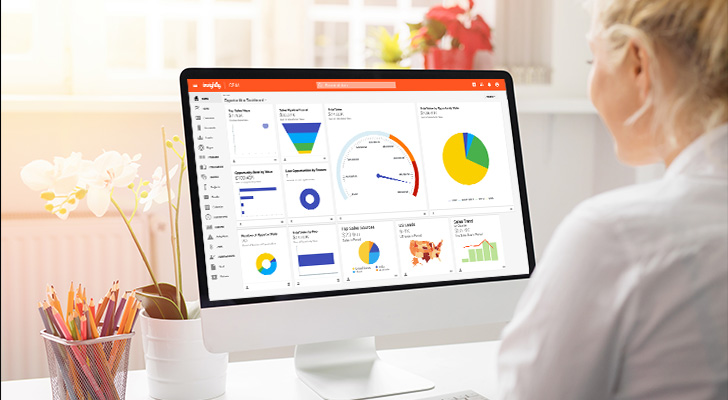CRM software is critical for SaaS companies. Your business runs on subscription revenue, which means customer relationships directly impact retention, growth, and your bottom line.
The right CRM gives you a centralized CRM database that tracks all customer interactions like sales calls, support tickets, and email conversations. With clean data, you can spot trends, predict churn, and find expansion opportunities.
In this guide, we’ll cover the must-have features every SaaS startup should look for in a CRM, then review the five best options available. We’re biased toward Insightly, but we’ll give you the facts to make the right choice for your business.
Key takeaways
- SaaS startups need CRMs that handle subscription lifecycles, track recurring revenue, and predict churn rather than treating every deal like a one-time transaction.
- Essential features include automated lead routing, clean contact management with duplicate prevention, and easy integrations that connect your CRM to billing, support, and marketing tools without developer help.
- Speed matters more than complexity since warm leads in SaaS can represent thousands in annual recurring revenue, but only if someone follows up fast with proper context.
- Insightly works well for SaaS startups because it combines CRM, marketing, and service on one platform with no-code customization and 200+ pre-built integrations for common SaaS tools.
- Alternatives like HubSpot fit content-driven growth strategies, Pipedrive works for sales-led motions, and Copper suits Google Workspace teams, while Salesforce typically requires too much overhead for most startups.
Must-have features to look for in a SaaS CRM for startups
Let’s cut right to it.
You can’t afford a CRM system that requires constant babysitting or a PhD just to be even somewhat usable across a 10 person team. You need something that works immediately and can scale as your team grows (without requiring a dedicated admin or endless CRM training sessions).
Consider this your (actually) practical checklist of the non-negotiables.
These are the core features that separate the actual startup-friendly CRMs from the glorified spreadsheets and custom-built-developer-havens that most sales teams wouldn’t have the sweetest clue how to navigate. Think functionality first, simplicity second.
Your CRM should help you and your team move faster, not bury everyone in setup tasks, button clicking, and confusing interfaces. If the CRM isn’t easy to use, it won’t get used. Period. And low CRM adoption means poor ROI on the investment.
Here’s what to look for:
1. Clean contact management systems
Your CRM needs to make logging customer info dead simple (and accessing it even simpler). If your sales team has to jump through flaming circus hoops just to update a phone number or find the notes from a prospect’s last demo call… you’re doing it wrong.
Look for systems that let you:
- Easily set required fields and data formatting rules upfront
- Access important info in as few clicks as possible
- Avoid accidental duplicate data
Duplicate contacts, missing email formats, or incomplete records shouldn’t be a daily battle. The best CRMs catch these issues before they become problems.
Remember:
Garbage in = garbage out.
Clean contact management is about more than just organization and ease of use. The cleaner your data, the more reliable your entire CRM system becomes.
2. Automated lead management and workflows
Speed wins in SaaS. When a prospect downloads a white paper or requests a demo, every minute counts. That lead could represent thousands in annual recurring revenue—but only if someone follows up fast.
Your CRM should handle the next steps (and the first follow up) automatically. The second a lead converts, your system should route them to the right sales rep based on territory, deal size, or product interest. If it’s a human’s job to manually sort prospects, that’s a one-way ticket to warm leads sitting in a queue for days while someone figures out who should call first.
Look for automated workflows that can:
- Route leads instantly to the right rep based on rules you set upfront
- Send alerts (like Slack notifications) so your team knows when hot prospects come in
- Schedule follow-up reminders automatically so nothing falls through the cracks
- Log activities without reps having to remember to update the system manually
The goal is simple: remove friction between lead generation and first contact. Your sales team should spend time talking to prospects, not shuffling data between systems.
3. Performance reporting across sales and marketing
Your dashboards should tell you what’s working at a glance without forcing you to hunt through 100 different apps just to figure out why sales hit or missed their targets this month.
SaaS startups especially need reporting that focuses on metrics that matter to your specific business model like monthly recurring revenue, churn rate, and pipeline velocity. If your CRM is built for businesses that sell services or one-time products, you’ll be trying to square-peg-round-hole your workflows and reports (and getting quite frustrated along the way).
Look for CRM reporting that gives you:
- One source of truth for both sales and marketing teams
- Clear segmentation by product, region, or customer type
- Real-time updates on pipeline health and deal progression
- Custom dashboards that show your KPIs without overwhelming you
- SaaS-specific metrics so you don’t need to customize everything (if you don’t want to)
Good reporting means faster decisions. For example, when you see enterprise deals stalling but SMB prospects converting quickly, you know where to focus your team’s energy.
4. Pipeline management and forecasting for recurring revenue
SaaS businesses like yours need forecasting tools that account for renewals, expansions, and churn risk—not just net-new deals that could close this quarter.
Look for a CRM system that can:
- Track subscription lifecycles from initial sale through renewal periods
- Flag at-risk accounts based on usage patterns or engagement drops
- Identify expansion opportunities when customers hit usage thresholds or show high engagement
- Predict recurring revenue across multiple time horizons, not just one-time deal values
A lot of CRMs treat every deal like a one-time transaction by default. That doesn’t work when you’re building a subscription business. You need visibility into SaaS-specific things like customer health scores, renewal probabilities, and expansion potential.
Good forecasting also helps you spot potential problems early. If you see usage declining three months before a renewal date, you can intervene with training or support. Or if you have power-users that’re getting close to their current plan’s limits, you can proactively talk about upgrades.
5. Easy integrations with your tech stack
Your CRM should connect to your billing system, support platform, and marketing tools (without requiring you to bring in dev help).
The reality is, most SaaS companies typically run on 5-10 different platforms to manage projects, sales, marketing, finance, etc. And data needs to flow between them automatically. Look for built0in or no-code integration builders that’ll let you set up new connections directly.
For example, when a new customer signs up through your marketing automation platform, that contact should appear in your CRM immediately. And when a deal closes, it should automatically trigger an invoice creation workflow in your billing system.
The best CRMs come with pre-built connectors for common SaaS tools. You want these integrations working within hours, not weeks of custom development work. For example, Insightly’s AppConnect provides 200+ pre-built integrations across all of the main categories like:
- Finance and accounting: QuickBooks, Xero, Stripe, PayPal
- Marketing and sales: Mailchimp, HubSpot, Drift, Calendly
- Productivity and collaboration: Slack, Microsoft Teams, Asana, Jira
- Customer service: Zendesk, Freshdesk, Intercom
As your startup grows, you’ll add more tools to your stack. Your CRM should adapt without forcing you to rebuild connections from scratch. Clean integrations mean your team spends time on customers instead of copying data between systems.
5 best CRMs for SaaS companies (and who each is best for)
We’re not going to pretend we have no bias here. Yes, we’re confident that Insightly is the best CRM choice on the market for plenty of SaaS startups like yours.
In this section, we’ll explain why we believe that’s the case. We’ll also present a handful of alternatives that are strong CRM platforms in their own right, with plenty of great functionality. In some cases, these alternatives may be a better fit for you.
We’ll share what you get with each option, who each is best for, and we’ll briefly touch on how each alternative compares to Insightly. Our goal is to present the facts to help you make the right decision for your business. We’re confident Insightly will be the answer, but we also weren’t all born yesterday.
1. Insightly
Insightly is designed to give SaaS startups a complete view of their prospects and customers while staying simple enough to adopt quickly. It combines CRM, marketing, and service into one platform, so scaling teams don’t need to bolt together multiple tools. For SaaS founders, that means faster implementation, fewer silos, and more time spent growing revenue.
What you get with Insightly
- CRM, marketing, and service modules built on a single database
- Fast setup and adoption compared to heavier enterprise CRMs
- No-code customization for fields, workflows, and layouts
- Built-in project management for deal-to-delivery handoffs
- AppConnect integration layer with 200+ connectors
Who is Insightly best for?
SaaS startups that want one unified platform to manage sales, marketing, and service without the cost or complexity of enterprise tools. If you need a CRM that’s purpose-built for mid-market businesses but won’t overwhelm your team with features you’ll never use, Insightly hits that sweet spot.
Start your free trial or request a demo to see how it works for your team.
2. HubSpot
HubSpot is a widely adopted CRM with strong roots in marketing automation. SaaS startups often start here for its generous free CRM and mature inbound tooling, then layer Sales/Service Hubs as they grow. The trade-off is that advanced automation, custom reporting, and predictive lead scoring live on paid Hubs, which can get expensive as headcount and usage scale.
What you get with HubSpot
- Free CRM with contact, deal, and pipeline tracking out of the box
- Marketing automation through the Marketing Hub
- Large app marketplace with hundreds of integrations
- Reporting dashboards that connect marketing and sales metrics
Who is HubSpot best for?
Startups focused on inbound marketing and content-led growth that can scale into paid tiers as their needs expand. If you’re already committed to the HubSpot ecosystem and your marketing team is driving most of your lead generation, this makes sense.
The free tier works well for very early-stage companies, but you’ll hit limits quickly. Most growing SaaS teams end up paying for multiple Hubs to get the functionality they need.
3. Monday.com
Monday.com is a flexible work management platform with a sales CRM built on its board system. Teams like the customization and cross-functional visibility across projects and deals. For SaaS, it can serve as a lightweight sales tracker, but the CRM experience still inherits a task-board paradigm rather than a purpose-built CRM object model.
What you get with Monday.com
- Visual, board-style interface for managing pipelines and tasks
- Flexible customization for sales, projects, and internal workflows
- Automations for reminders, assignments, and notifications
- Collaboration features for cross-functional teams
Who is Monday.com best for?
Teams that already use Monday for operations and want a light CRM layer alongside project tracking. If your team is comfortable with board-based workflows and you need something that bridges project management and sales tracking, this could work.
You’ll get solid project visibility, but you might find yourself working around the platform when you need deeper CRM functionality like advanced forecasting or subscription revenue tracking.
4. Pipedrive
Pipedrive is a sales-first CRM known for its visual pipelines and rep-friendly UX. It’s popular with sales-led SaaS teams for fast deal tracking, email sync, and straightforward forecasting. You’ll usually add separate tools for marketing automation and post-sale service workflows.
What you get with Pipedrive
- Drag-and-drop pipelines that are simple for sales reps to use
- Automations for follow-ups, activity tracking, and deal progression
- AI-powered sales assistant to suggest next actions
- Goal tracking and insights to keep sales execution sharp
Who is Pipedrive best for?
SaaS startups with a sales-led motion that want a rep-friendly CRM to manage deals. If your sales team drives most of your growth and you’re comfortable managing marketing and customer success through separate tools, Pipedrive keeps things focused.
The interface is clean and adoption tends to be fast, but you’ll need to layer on other platforms as you scale beyond pure sales execution.
5. Copper
Copper integrates directly into Google Workspace, making it a solid choice for SaaS startups that just want something simple that lives directly inside of Gmail and Google Calendar. Its strength is usability – teams can manage relationships without leaving their inbox.
What you get with Copper
- Works natively inside Gmail and Google Calendar
- Automatic capture of emails, meetings, and contact details
- Clean interface with fast onboarding for Google-first teams
- Basic reporting and forecasting for sales pipelines
Who is Copper best for?
Startups that run fully on Google Workspace and value ease of use and quick adoption. If your team practically lives in Gmail and you want CRM functionality that doesn’t require learning a new interface, Copper removes that friction.
The trade-off is functionality. You’ll get solid contact management and pipeline tracking, but advanced features like marketing automation or detailed subscription forecasting will require additional tools.
Should SaaS startups use Salesforce as their CRM?
For most SaaS startups, the answer is likely no. Salesforce requires more time, money, and expertise to set up properly for most startups.
To be clear here, Salesforce is incredibly powerful. We won’t argue with that for a second. But power comes with a price that goes way beyond the monthly subscription fees.
Remember those must-have features we covered earlier? Specifically the point about simplicity and ease of use? Salesforce tends to sit on the opposite end of that spectrum. You’ll essentially need a small army of admins, consultants, and developers to set it up properly. Then you’ll need to train your entire team on a system that’s often built for enterprise complexity, not startup speed.
The reality is, your 10-person sales team doesn’t need the same CRM infrastructure as a Fortune 500 company. They need something that works immediately, is easy to adopt, and scales as you grow without requiring dedicated admins or endless training sessions.
If you want Salesforce-level customization and reporting without the enterprise overhead, look for a Salesforce alternative that’s purpose-built for scaling startups. Something like Insightly gives you the power you need with setup times measured in days, not months.
Get started with Insightly CRM today
Insightly CRM is built for SaaS businesses that need more than basic contact management but don’t want enterprise complexity. You get CRM, marketing, and service tools working together on one platform, so your teams stay aligned as you scale.
Ready to see how it works? Start your free 14-day trial or request a demo to see how Insightly can help your company grow.



